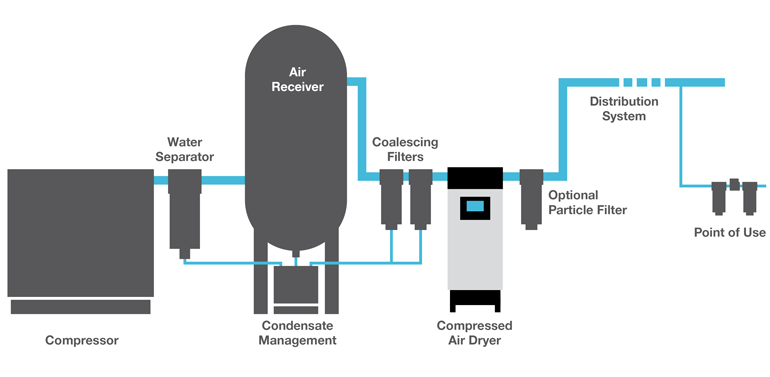Considerations for Selecting a Compressed Air Filter

Compressed air isn’t inherently clean; like the ambient environment it’s drawn from, the air in your compressor system is filled with a variety of particles, aerosols, and vapors that can contaminate end processes and products, as well as harm machinery and other equipment. This is where compressed air filters come in! By implementing a robust filtration system, you’re improving the quality of your compressed air while simultaneously increasing your system’s efficiency. Keep in mind that the amount and types of filters needed will be dependent on the quality of the air your application or process requires. Now let’s look at the different types of filters, as well as the questions that you can ask, that will help you choose the correct filter(s) for your compressor system.
Types of Compressed Air Filters
First up – what is a compressed air filter, anyway? The answer is simple. It’s a piece of ancillary compressed air equipment that helps to remove any unwanted and potentially harmful contaminants from the compressed air; as mentioned above, these contaminants can be aerosols, particulates, or vapors. Particulates are small, solid particles, like dust, dirt, metal particles from pipe corrosion, and pollen. Aerosols are small liquid droplets (i.e. oil and/or water, depending on the type of compressor), and vapors are liquids that have been converted into a gas.
Compressed air filters fall into three categories: coalescing filters, vapor removal filters, and dry particulate filters. While each type ultimately produces the same result (the removal of contaminants), each of the three function in different ways:
Coalescing filters remove water, oil, and aerosols from the air while a re-entrainment barrier prevents the contaminants from reentering the air. These filters also remove particulates from compressed air, trapping them within the filter media, though this can lead to pressure drops if they aren’t changed regularly. Coalescing filters remove most contaminants very well, reducing particulate levels down to 0.1 micron in size and liquids down to 0.01 ppm.
A low-cost alternative to a coalescing filter is a mist eliminator. While it doesn’t produce the same level of filtration as coalescing filters, it does offer a smaller pressure drop (about 1 psi). This allows systems to operate at lower pressure, which helps decrease energy costs. Mist eliminators are typically best used with liquid condensate and aerosols in lubricated compressor systems.
Vapor removal filters operate on the principal of adsorption. They typically remove lubricant aerosols by using activated carbon granules, carbon cloth or paper. Vapor removal filters work well after coalescing filters, as they can catch and remove gaseous lubricants that will go through the coalescing filter.
Dry particulate filters are usually employed to remove desiccant particles after an adsorption dryer. They can also be implemented at point of use. Dry particulate filters operate in a manner identical to a coalescing filter.
What Filter is Right for My Air Compressor?
Not all compressed air applications are made equal! Different applications require different levels of filtration, so to select the right type of filter for your compressor system, you need to really know your application. For example, if the compressed air is being used to power processes in the pharmaceutical or food and beverage industries, you’ll most likely need a higher quality of compressed air than if you’re using compressed air to power pneumatic tools or fill tires.
You should also ask yourself if your process will be damaged by oil, or if some oil can still be present in air. If your application is sensitive to oil, installing an inline coalescing filter can limit damaging oil interacting with your end use. Also consider how important energy efficiency is to your facility! Lower energy usage leads to lower power bills, and who doesn’t like that? High-efficiency filters can produce extremely clean air (think removing particulates less than 0.01 microns) while minimizing the pressure drop.
Do I Need to Replace My Compressed Air Filter?
Determining when a filter needs replacement depends on things like your air compressor’s hours of operation and the required quality of the compressed air; pressure drops can also indicate a filter needs to be replaced. Consider these four questions when thinking about whether to change a compressed air filter:
Is the manufacturer’s service life expired?
Has an air audit revealed that air quality is below acceptable limits?
Are pressure drops exceeding acceptable levels?
Are pressure drops exceeding the manufacturer’s change point?
Answering yes to any of these questions indicates it’s time for a new filter. You many also consider replacing filter elements before the recommended pressure drops or air quality issues occur, as the increased energy cost from reduced air pressure could be more than that of a new filter.



Leave a Reply
Want to join the discussion?Feel free to contribute!